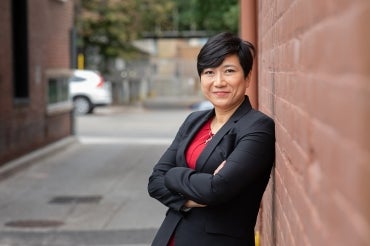“We need to make the patient the centre of care and enable them to have their care managed holistically,” says Associate Professor Emily Seto (Photo by Johnny Guatto)

“We need to make the patient the centre of care and enable them to have their care managed holistically,” says Associate Professor Emily Seto (Photo by Johnny Guatto)
Published: December 12, 2012
From stores and movie theatres to banks and airlines, the service industry has undergone a massive digital transformation in recent years to better serve customers – a shift that gathered further speed during COVID-19.
But the same can’t always be said of the health-care sector.
That’s something the University of Toronto’s Emily Seto wants to change – which is why she’s launched a research study to help speed the transition.
“I don’t think anyone would argue that our health and health care are one of the most important aspects of our lives,” says Seto, associate professor at the Dalla Lana School of Public Health’s Institute of Health Policy, Management and Evaluation (IHPME) and a member of the Centre for Global eHealth Innovation and the Techna Institute, both based at the University Health Network. “So, it’s ironic that the health-care sector has been so much slower than other service sectors to use digital technology in changing how it cares for people.”
Keeping people who live with chronic conditions from having to make repeated trips to the hospital is one of Seto’s goals – and she says “virtual care” can help.
“People with conditions like heart disease and chronic obstructive pulmonary disease (COPD) will often be hospitalized to treat their condition – then they will be discharged, only to return to the hospital when they get sick again,” she says.
“This isn’t good for the patient and it creates a huge cost to the health-care system that I think can be avoided with a different model.”
In 2020, Seto was awarded $1.2 million from the Canadian Institutes of Health Research (CIHR) to research and test a project called the SMaRT (Safe, Managed and Responsive Transitions) Clinic.
The SMaRT Clinic will include a nurse or nurse practitioner as the point person for communicating with the patient and the care team to plan and execute a strategy that accounts for all the patient’s health conditions. The nurse will follow the patient in the months following discharge from the hospital via an app on a smartphone (patients without a smartphone will be provided with one). Symptoms and important metrics will be tracked, such as weight and blood pressure. An algorithm will determine when there is a concern, so the nurse can respond to these alerts and consult other providers such as specialists as needed.
“Our health-care system is based too much on caring for people reactively and in an episodic manner by a variety of specialists who work in siloes,” says Seto. “We need to make the patient the centre of care and enable them to have their care managed holistically.”
Seto and her research team will test their model at four Ontario hospitals: Health Sciences North in Sudbury, Oak Valley Health (located northeast of Toronto), the William Osler Health System (which serves Brampton, Ont. and the western Toronto administrative district of Etobicoke), and Women’s College Hospital, one of U of T’s nine partner hospitals.
“Each of these hospitals represents a region that is quite different than the others,” says Seto. “Some serve very urban populations, others include patients in rural and remote areas and they all include people of with diverse sociodemographic characteristics. Some may have an affinity to using a smartphone, others may not or can’t afford one.
“Our goal is to understand workflows and cultures in the hospitals and the people who need their services and how they would be able to adopt a model like our SMaRT Clinic.”
To develop the virtual care model that meets all the health-care needs of a patient, Seto says studying how nurses in geriatric care settings work with their patients could bring useful insights.
“Older adults often have a host of conditions they are dealing with, so their nurses develop a specialty in treating them in a more holistic way. I think that approach could be adapted to the SMaRT model.”
Onil Bhattacharyya, a member of the SMaRT project team, says the project complements Ontario Health Teams (OHT), an initiative launched by the Province of Ontario to promote integrated patient care.
“Emily is addressing the challenge of integrating care for people with complex needs with a sophisticated approach to helping providers to collect the relevant information to prioritize multiple clinical and social issues and co-ordinate care across a broad team that includes patients and caregivers,” says Bhattacharyya, senior scientist and family physician at Women’s College Hospital and associate professor in IHPME. “Solving this is key to deriving value from integrated care delivery systems like OHT – and she is well on her way to finding solutions that work.”
Seto is drawing on both her background in biomedical engineering and her PhD in health services research for the project.
“I’m interested in the engineering side like designing new innovations, but also in the more health services side and understanding people’s needs,” she says. “For this project, we will generate information from both sides and bring it together, with the goal of designing a way to implement a model that we can get into the hands of patients and providers.”
A century after the discovery of insulin, U of T and its hospital and industry partners have built a culture of discovery, innovation and collaboration that has transformed health care and continues to have a ripple effect worldwide. This article is part of a series featuring researchers working on medical and health innovations for the future.
-With files from Alisa Kim



